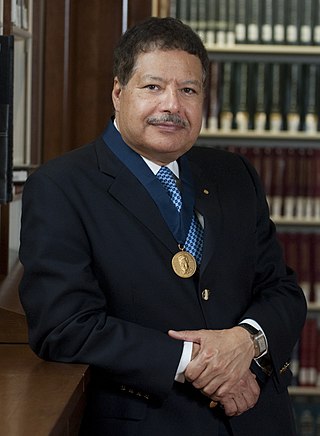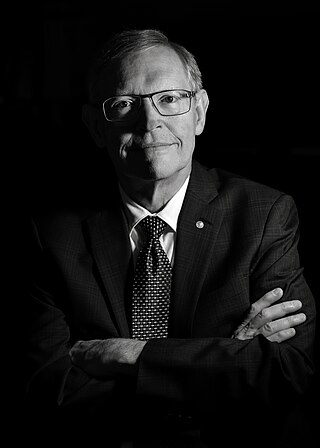Related Research Articles

Bonnie Lynn Bassler is an American molecular biologist;the Squibb Professor in Molecular Biology and chair of the Department of Molecular Biology at Princeton University;and a Howard Hughes Medical Institute Investigator. She has researched cell-to-cell chemical communication in bacteria and discovered key insights into the mechanism by which bacteria communicate,known as quorum sensing. She has contributed to the idea that disruption of chemical signaling can be used as an antimicrobial therapy.

Ahmed Hassan Zewail was an Egyptian-American chemist,known as the "father of femtochemistry". He was awarded the 1999 Nobel Prize in Chemistry for his work on femtochemistry and became the first Egyptian and Arab to win a Nobel Prize in a scientific field,and the second African to win a Nobel Prize in Chemistry. He was the Linus Pauling Chair Professor of Chemistry,a professor of physics,and the director of the Physical Biology Center for Ultrafast Science and Technology at the California Institute of Technology.

Howard Alvin Stone is the Donald R. Dixon '69 and Elizabeth W. Dixon Professor in Mechanical and Aerospace Engineering at Princeton University. His field of research is in fluid mechanics,chemical engineering and complex fluids. He became an Editor of the Annual Review of Fluid Mechanics in 2021.

William Esco Moerner,also known as W. E. Moerner,is an American physical chemist and chemical physicist with current work in the biophysics and imaging of single molecules. He is credited with achieving the first optical detection and spectroscopy of a single molecule in condensed phases,along with his postdoc,Lothar Kador. Optical study of single molecules has subsequently become a widely used single-molecule experiment in chemistry,physics and biology. In 2014,he was awarded the Nobel Prize in Chemistry.
Kevin K. Lehmann is an American chemist and spectroscopist at the University of Virginia,best known for his work in the area of intramolecular and collisional dynamics,and for his advances in the method of cavity ring down spectroscopy (CRDS).
In network science,a gradient network is a directed subnetwork of an undirected "substrate" network where each node has an associated scalar potential and one out-link that points to the node with the smallest potential in its neighborhood,defined as the union of itself and its neighbors on the substrate network.
Hans Wolfgang Liepmann was an American fluid dynamicist,aerospace scientist and emeritus Theodore von Kármán Professor of Aeronautics at the California Institute of Technology.
The Earle K. Plyler Prize for Molecular Spectroscopy and Dynamics is a prize that has been awarded annually by the American Physical Society since 1977. The recipient is chosen for "notable contributions to the field of molecular spectroscopy and dynamics". The prize is named after Earle K. Plyler,who was a leading experimenter in the field of infrared spectroscopy;as of 2007 it is valued at $10,000. The prize is currently sponsored by the AIP Journal of Chemical Physics.
Edward John Hinch is a Professor of fluid dynamics at the University of Cambridge,and fellow of Trinity College,Cambridge.

Adilson E. Motter is the Charles E. and Emma H. Morrison Professor of Physics at Northwestern University,where he has helped develop the concept of synthetic rescue in network biology as well as methods to control the nonlinear dynamics of complex networks. In joint work with Takashi Nishikawa,he discovered the phenomenon of converse symmetry breaking. Motter's research is focused on complex systems and nonlinear phenomena,primarily involving complex networks,systems biology,chaos and statistical physics.
Michael T. Bowers is an American mass spectroscopist,a professor in the department of chemistry and biochemistry at the University of California,Santa Barbara faculty.
In physics and engineering,kinetics is the branch of classical mechanics that is concerned with the relationship between the motion and its causes,specifically,forces and torques. Since the mid-20th century,the term "dynamics" has largely superseded "kinetics" in physics textbooks,though the term is still used in engineering.
Srikanth Sastry is an Indian physicist. He is a Boston University alumnus and he along with Raghunathan Srianand were awarded the Shanti Swarup Bhatnagar Prize for Science and Technology in physical sciences in 2008.
Thomas S. Lundgren is an American fluid dynamicist and Professor Emeritus of Aerospace Engineering and Mechanics at the University of Minnesota He is known for his work in the field of theoretical fluid dynamics. In 2006,Lundgren received Fluid Dynamics Prize by the American Physical Society "for his insightful theoretical contributions to numerous areas of fluid mechanics,most notably in the fields of turbulence and vortex dynamics"

Michael Elmhirst Cates is a British physicist. He is the 19th Lucasian Professor of Mathematics at the University of Cambridge and has held this position since 1 July 2015. He was previously Professor of Natural Philosophy at the University of Edinburgh,and has held a Royal Society Research Professorship since 2007.
Veronica Vaida is a Romanian-Hungarian-American chemist and professor at the University of Colorado Boulder. She is an expert in environmental chemistry and aerosols.

Asoke Nath Mitra was an Indian theoretical physicist. He was a lifetime professor emeritus at Delhi University. He is known for his work in nuclear physics,particle physics and quantum field theory and in particular,for his fundamental contributions in obtaining the exact solution of the nucleon 3- body problem with separable potentials which led to the few nucleon studies,quark-recoil effect,development of an integrated dynamics of 2- and 3- body systems from nucleons to quarks as well as for the development of quark dynamics and relativistic quark models for hadrons in the Bethe-Salpeter framework. He was awarded the Shanti Swarup Bhatnagar Prize in 1969.

Geraldine Lee Richmond is an American chemist and physical chemist who is serving as the Under Secretary of Energy for Science in the US Department of Energy. Richmond was confirmed to her DOE role by the United States Senate on November 5,2021. Richmond is the Presidential Chair in Science and professor of chemistry at the University of Oregon (UO). She conducts fundamental research to understand the chemistry and physics of complex surfaces and interfaces. These understandings are most relevant to energy production,atmospheric chemistry and remediation of the environment. Throughout her career she has worked to increase the number and success of women scientists in the U.S. and in many developing countries in Africa,Asia and South America. Richmond has served as president of the American Association for the Advancement of Science,and she received the 2013 National Medal of Science.
Raymond Ethan Goldstein FRS FInstP is the Alan Turing Professor of Complex Physical Systems in the Department of Applied Mathematics and Theoretical Physics (DAMTP) at the University of Cambridge and a Fellow of Churchill College,Cambridge.

John Francis Brady is an American chemical engineer and the Chevron Professor of Chemical Engineering and Mechanical Engineering at the California Institute of Technology. He is a fluid mechanician and creator of the Stokesian dynamics method for simulating suspensions of spheres and ellipsoids in low Reynolds number flows. He is an elected fellow of the American Physical Society,a fellow of the Society of Rheology,as well as a member of the National Academy of Sciences,the National Academy of Engineering,and the American Academy of Arts and Sciences.
References
- ↑ "Bassler and Su Named American Physical Society Fellows". uh.edu. June 3, 2015. Retrieved April 22, 2021.